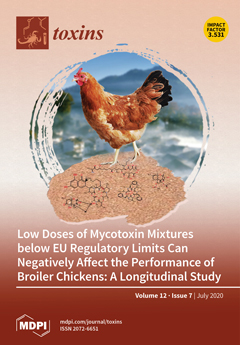Vermeersiekte or “vomiting disease” is an economically important disease of ruminants following ingestion of
Geigeria (
G.) species in South Africa. Sheep are more susceptible, and poisoning is characterized by stiffness, regurgitation, bloat, paresis, and paralysis. Various sesquiterpene lactones have been implicated
[...] Read more.
Vermeersiekte or “vomiting disease” is an economically important disease of ruminants following ingestion of
Geigeria (
G.) species in South Africa. Sheep are more susceptible, and poisoning is characterized by stiffness, regurgitation, bloat, paresis, and paralysis. Various sesquiterpene lactones have been implicated as the cause of poisoning. The in vitro cytotoxicity of two sesquiterpene lactones, namely, ivalin (purified from
Geigeria aspera) and parthenolide (a commercially available sesquiterpene lactone), were compared using mouse skeletal myoblast (C2C12) and rat embryonic cardiac myocyte (H9c2) cell lines, representing the oesophageal, skeletal and cardiac muscles, which are affected in sheep. For 24, 48, and 72 h, both cell lines were exposed. A colorimetric viability assay, 3-(4,5-dimethylthiazol-2-yl)-2,5-diphenyltetrazolium bromide (MTT), was used to assess cytotoxicity. A concentration-dependent cytotoxic response was observed in both cell lines, however, the C2C12 cells were more sensitive, with the half-maximal effective concentrations (EC
50s) ranging between 2.7 and 3.3 µM. In addition, the effect that ivalin and parthenolide has on desmin, an important cytoskeletal intermediate filament in myocytes, was evaluated using the C2C12 myoblasts. Disorganization and aggregation of desmin were caused by both sesquiterpene lactones, which could clarify some of the ultrastructural lesions described in vermeersiekte.
Full article






